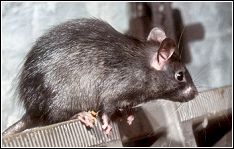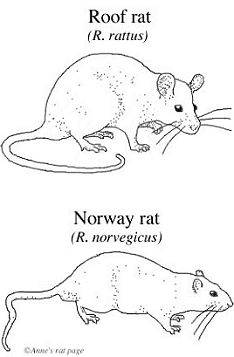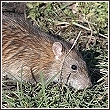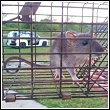Roof Rats
Do you have Roof rats in your attic? We know how to get rid of roof rats. First, let's describe this high climbing and persistent attic dweller. Roof Rats (Rattus rattus), which are also called black or ship rats, can be black, brown or gray. They have a tail that is longer than their body, that is charcoal grey in color, uniform in width, and is strong and nimble enough to use for grasping. Roof rats love to hang out in high places, are great at climbing, and will gladly move into your attic. Roof rats like living in buildings and homes, nesting in attics, running along rafters, pipes and electrical wires.
Roof rats are one of the two most common species that typically bother residents in Cape Coral, Fort Myers, Pine Island, Sanibel and other communities in Southwest Florida. We are local, experienced rat removal professionals and we can solve your roof rat problems for good.
Getting Rid Of Roof Rats
It can get a bit tricky if you are trying to get rid of roof rats yourself. They are high climbers, highly intelligent and afraid of new things (neophobic). Being neophobic, a rat will often avoid traps and bait stations that are laid out simply because they are "new" and deemed untrustworthy by the rat.
We know how to get rid of roof rats in your attic forever. Repairs must be comprehensive and done with the right materials in order to get roof rats out and keep them out forever. Power lines, tree branches and other attic entry paths should also be addressed when doing a full, proper roof rat exclusion as well as getting rid of the smells that their urine, feces and birthing fluids leave behind. We know what to do!
Meet The Roof Rat
Roof rats have infested every corner of the world, and the early sailing ships from East Asia originally brought roof rats to North America.

The Difference Between
Roof Rats And Norway Rats
Roof rats are commonly mistaken for Norway rats and vice versa. Roof rats weigh half as much as Norway rats. They can be black, brown or gray whereas a Norway rat is not typically black. A roof rat belly will be a uniform color of all buff, gray or white and a Norway rat belly is white with gray under fur. Norway rats prefer lower areas such as burrows, crawl spaces, basements and sewers whereas roof rats prefer higher areas. Norway rats have a tail that is shorter than their body, is tan or pink in color, not prehensile and it is fatter at the tail's base. The roof rat's muzzle is skinny, long and pointed whereas the Norway's is more blunt, wide and short. A Norway rat has small ears and a roof rat has larger flimsy ears.

You can learn more about the difference between Norway and Roof rats on our page about rats in general - where the nesting habits of each species are discussed in more depth.
Range
Roof rats can be found in the Gulf States, Pacific Coast, Florida, Arkansas and down to the lower half of the East Coast and Hawaiian Islands. They prefer warmer climates.
Reproduction
After 20-24 days of conception, hairless and eyes closed, 5-8 young per litter emerge in the nest. Within one week fur has formed, at 9-14 days their eyes open, they nurse until 4-5 weeks old and are totally on their own at 3 months of age - and ready to breed.
Roof rats have the fastest breeding cycle of all rat types. Two roof rats in the attic can quickly become ten.
Feeding Habits
Roof Rats are omnivorous and will consume almost anything and will travel 100 to 300 feet to find it. Chewing on electrical wires is a common practice of these attic dwelling rodents.
1242 SW Pine Island Rd., Suite 310
Cape Coral, Florida 33991-2126
help@totalwildlifecontrol.com

















